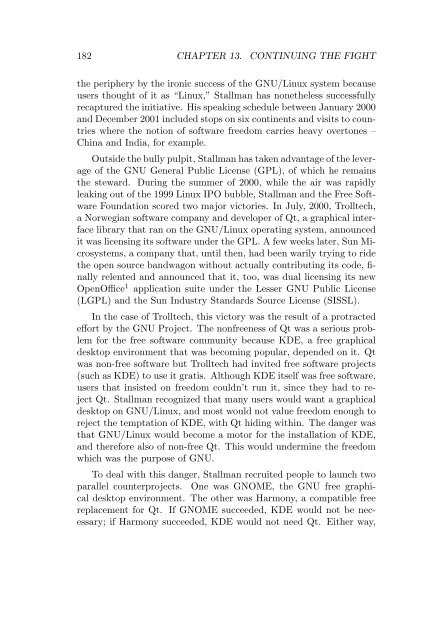You also want an ePaper? Increase the reach of your titles
YUMPU automatically turns print PDFs into web optimized ePapers that Google loves.
182 CHAPTER 13. CONTINUING THE FIGHT<br />
the periphery by the ironic success of the GNU/Linux system because<br />
users thought of it as “Linux,” Stallman has nonetheless successfully<br />
recaptured the initiative. His speaking schedule between January 2000<br />
and December 2001 included stops on six continents and visits to countries<br />
where the notion of software freedom carries heavy overtones –<br />
China and India, for example.<br />
Outside the bully pulpit, Stallman has taken advantage of the leverage<br />
of the GNU General Public License (GPL), of which he remains<br />
the steward. During the summer of 2000, while the air was rapidly<br />
leaking out of the 1999 Linux IPO bubble, Stallman and the Free Software<br />
Foundation scored two major victories. In July, 2000, Trolltech,<br />
a Norwegian software company and developer of Qt, a graphical interface<br />
library that ran on the GNU/Linux operating system, announced<br />
it was licensing its software under the GPL. A few weeks later, Sun Microsystems,<br />
a company that, until then, had been warily trying to ride<br />
the open source bandwagon without actually contributing its code, finally<br />
relented and announced that it, too, was dual licensing its new<br />
OpenOffice 1 application suite under the Lesser GNU Public License<br />
(LGPL) and the Sun Industry Standards Source License (SISSL).<br />
In the case of Trolltech, this victory was the result of a protracted<br />
effort by the GNU Project. The nonfreeness of Qt was a serious problem<br />
for the free software community because KDE, a free graphical<br />
desktop environment that was becoming popular, depended on it. Qt<br />
was non-free software but Trolltech had invited free software projects<br />
(such as KDE) to use it gratis. Although KDE itself was free software,<br />
users that insisted on freedom couldn’t run it, since they had to reject<br />
Qt. Stallman recognized that many users would want a graphical<br />
desktop on GNU/Linux, and most would not value freedom enough to<br />
reject the temptation of KDE, with Qt hiding within. The danger was<br />
that GNU/Linux would become a motor for the installation of KDE,<br />
and therefore also of non-free Qt. This would undermine the freedom<br />
which was the purpose of GNU.<br />
To deal with this danger, Stallman recruited people to launch two<br />
parallel counterprojects. One was GNOME, the GNU free graphical<br />
desktop environment. The other was Harmony, a compatible free<br />
replacement for Qt. If GNOME succeeded, KDE would not be necessary;<br />
if Harmony succeeded, KDE would not need Qt. Either way,


